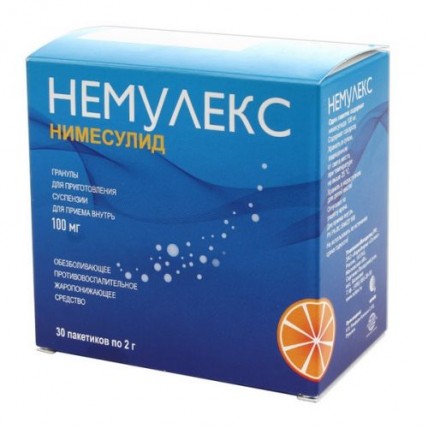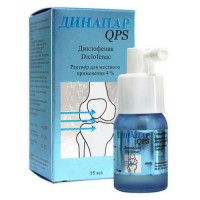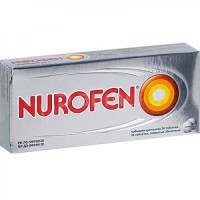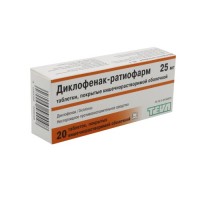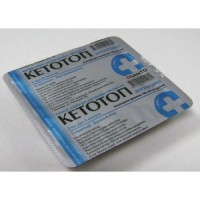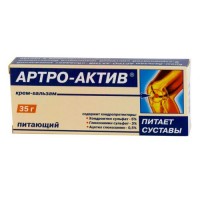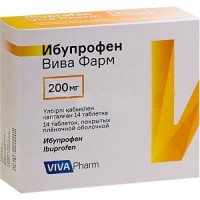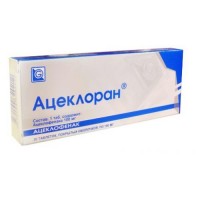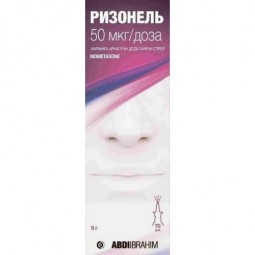Nemuleks 100 mg / g 2 30s granules for oral suspension
- $26.20
The instruction for medical use of Nemulex Torgovoye medicine a name of Nemulex the International unlicensed name Nimesulide Dosage Form of the Granule for preparation of suspension for intake, 100 mg Structure One bag contains active agent — Nimesulide of 100 mg, excipients: macrogoal tsetostearat (A25 cremophore), anhydrous citric acid, silicon dioxide colloidal anhydrous, sucrose, fragrance orange. Description of the Granule of yellowish color. At dissolution of granules in 100 ml of water suspension of light yellow color is formed. Pharmacotherapeutic group Anti-inflammatory and antirheumatic drugs. Nonsteroid anti-inflammatory and antirheumatic drugs. Other non-steroidal anti-inflammatory drugs. Nimesulide. The ATX M01AX17 code the Pharmacological Pharmacokinetics Absorption properties at intake — high (meal reduces absorption speed, without influencing its degree). Time of achievement of the maximum concentration in blood plasma (TCmax) — 1.5-2.5 h. Communication with proteins of plasma — 95%, with erythrocytes — 2%, with lipoproteins — 1%, with an acid alfa1-glycoprotein — 1%. Change of a dose does not influence extent of binding. The maximum concentration (Cmax) — 3.5-6.5 mg/l. Distribution volume — 0.19-0.35 l/kg. Well gets into acidic environment of the center of inflammation (40%), synovial fluid (43%). Easily gets through gistogematichesky barriers. It is metabolized in a liver by fabric monooxygenases. The main metabolite — 4 hydroxynimesulide (25%), has similar pharmacological activity, but owing to reduction of the size of molecules is capable to diffuse quickly on hydrophobic channel COG-2 to an active center of binding of methyl group. 4 hydroxynimesulide are water-soluble connection for which removal are not required glutathione and conjugation tests of the II phase of metabolism (sulphation, a glyukuronirovaniye, etc.). Elimination half-life (T1/2) of Nimesulide — 1.56-4.95 h, 4 hydroxynimesulides — 2.89-4.78 Parts 4 hydroxynimesulide is removed by kidneys (65%) and with bile (35%), is exposed to enterogepatichesky recirculation. The pharmacodynamics Non-steroidal anti-inflammatory drug (NPVP), renders anti-inflammatory, analgeziruyushchy, febrifugal and antiagregantny action. Unlike other NPVP selectively suppresses cyclooxygenase-2 (TsOG-2), slows down synthesis of prostaglandins (Pg) in the inflammation center, has less expressed the oppressing impact on cyclooxygenase-1 (TsOG-1) (causes the side effects connected with oppression of synthesis of Pg in healthy fabrics less often). Indications treatment of acute pains symptomatic treatment of an osteoarthritis with a pain syndrome treatment of primary dysmenorrhea Drug is intended for symptomatic therapy, reducing pains and inflammations at the time of use, does not influence progressing of a disease. It is necessary to appoint Nimesulide only as drug of the second line. The decision on therapy has to be made by Nimesulide on the basis of assessment of all risks for the specific patient. Route of administration and doses Inside. Contents of 1 bag of granulate are dissolved in 80-100 ml of water. The recommended dose for adults makes 100 mg (1 bag) 2 times a day after a meal. The maximum daily dose — 200 mg. Minimum effective dose has to be appointed throughout shorter span for minimization of risk of development of side reactions. The maximum duration of administration of drug should not exceed 15 days. Patients of advanced age the dose decline for patients of advanced age is not required. Regular clinical control of a condition of the patient is recommended. Patients with chronic kidney disease the Patients with chronic kidney disease need decrease in a daily dose to 100 mg. Children Use is contraindicated to children up to 18 years. Side effects often (≥ 1/100, & lt, 1/10): diarrhea, nausea, vomiting, increase in level of liver enzymes sometimes (≥ 1/1000, & lt, 1/100): dizziness, hypertensia, short wind, a constipation, a meteorism, gastritis, an itching, rash, the increased perspiration, hypostases seldom (≥ 1/10000, & lt, 1/1000): anemia, eosinophilia, hypersensitivity, hyperpotassemia, sensation of fear, nervousness, dreadful dreams, indistinct sight, tachycardia, hemorrhage, lability of arterial blood pressure, inflows, erythema, dermatitis, dysuria, hamaturia, urination delay, weakness, asthenia very seldom (& lt, 1/10000): thrombocytopenia, a pancytopenia, a purpura, an anaphylaxis, a headache, drowsiness, encephalopathy (a syndrome to Reja), vertigo, a visual disturbance, asthma, a bronchospasm, an abdominal pain, dyspepsia, stomatitis, a tar-like chair, gastrointestinal bleeding, an ulcer and perforation of a 12-perstny gut, an ulcer and perforation of a stomach, hepatitis, lightning hepatitis (including lethal outcomes), jaundice, a cholestasia, urticaria, a Quincke's disease, a face edema, an erythema poliformny, Stephens-Johnson's syndrome, a toxic epidermal necrolysis, a renal failure, an oliguria, interstitial nephrite, the Contraindication hypothermia hypersensitivity to Nimesulide or to other components of drug the giperergichesky reactions taking place in the past (for example, a bronchospasm, rhinitis, a small tortoiseshell) in connection with intake of acetylsalicylic acid (ASK) or other non-steroidal anti-inflammatory drugs the hepatotoxic reactions to Nimesulide taking place in the past in the anamnesis the accompanying intake of other substances with potential hepatotoxicity alcoholism, drug addiction ulcer of stomach or duodenum in an aggravation phase, existence in the anamnesis of an ulcer, perforation or bleeding in digestive tract existence in the anamnesis of cerebrovascular bleedings or other hemorrhages and also the diseases which are followed by bleeding serious violations of fibrillation serious heart failure a serious renal failure (clearance of creatinine (CC) of of 30 ml/min.) a liver failure patients with symptoms of cold or flu children's and teenage age to 18 years pregnancy and the period of feeding by a breast hereditary intolerance of fructose, glucose galactose malabsorption, insufficiency of invertase-isomaltase in diseases of a liver and increase in liver enzymes With care the Coronary Heart Disease (CHD), heart failure, hypertensia, a dislipidemiya / lipidemia, diabetes, diseases of peripheral arteries, hemorrhagic diathesis, smoking, a renal failure (KK of 30-60 ml/min.), gastrointestinal diseases in the anamnesis (ulcer colitis, Crohn's disease), advanced age, long use of NPVP, a concomitant use of anticoagulants (including warfarin), antiagregant (including ASK, klopidogret), oral glucocorticosteroids (GKS), selective serotonin reuptake inhibitors (including to tsitalopra, fluoxetine, paroksetin, sertraline). Medicinal interactions the Concomitant use of the drug Nemulex with corticosteroids, antithrombocytic means and selective serotonin reuptake inhibitors (SSRIs) increases risk of developing of a gastrointestinal ulcer or bleeding. The patients applying warfarin or similar anticoagulants and also acetylsalicylic acid at simultaneous use with the drug Nemulex have an increased risk of developing of bleedings. Therefore such combination is not recommended, and at severe forms of disturbance of blood clotting it is contraindicated. If such combination cannot be avoided, regular control of a condition of a coagulant system of blood is necessary. Nemulex can reduce effect of diuretics and other antihypertensive drugs. At some patients with a renal failure at the joint prescribing of the drug Nemulex and APF inhibitors, antagonists of angiotensin II or substances suppressing the system of cyclooxygenase perhaps further deterioration in function of kidneys and developing of an acute renal failure which, as a rule, is reversible. Therefore it is necessary to appoint joint intake of these drugs with care, especially for elderly patients. Patients have to receive enough liquid, and renal function should be controlled carefully after the beginning of combination therapy. At healthy volunteers Nimesulide can temporarily reduce diuretic effect of furosemide and removal of sodium, and to a lesser extent — potassium therefore at simultaneous use of Nimesulide and furosemide the patients with a renal failure or hearts should observe extra care. Joint intake of Nimesulide and furosemide concentration - time' (AUC) and decrease in cumulative excretion of furosemide without change of renal clearance of furosemide leads to reduction (approximately for 20%) the areas under a curve '. Nemulex can reduce clearance of lithium that leads to increase in level of lithium in blood plasma and its toxicity. When prescribing the drug Nemulex the patients receiving therapy by lithium drugs should exercise frequent control of level of lithium in plasma. At simultaneous use with glibenclamide, theophylline, warfarin, digoxin, Cimetidinum and antiacid drugs of clinically significant interactions it is noted. Nimesulide suppresses activity of CYP2C9 enzyme. At a concomitant use with the drug Nemulex of the drugs which are substrates of this enzyme, concentration of these drugs in plasma can increase. When prescribing the drug Nemulex less than in 24 hours prior to or less than in 24 hours after reception of a methotrexate, it is required to be careful as in such cases methotrexate level in plasma and, respectively, toxic effects of this drug can increase. At simultaneous use with cyclosporine the increase in nephrotoxicity of the last is possible. The researches in vitro showed that Nimesulide is forced out from places of binding by tolbutamide, salicylic acid and valproic acid. In spite of the fact that these interactions were defined in blood plasma, the specified effects were not observed in the course of clinical use of drug. During drug treatment Nemulex it is necessary to avoid simultaneous use with the drugs having hepatotoxic effect and also alcohol abuses as these substances can increase risk of emergence of side reactions from a liver. Special instructions For reduction of risk of development of side effects it is necessary to use drug in a minimal effective dose with the smallest duration. If the condition of the patient does not improve, treatment needs to be stopped. It is necessary to stop administration of drug in case of temperature increase or development against the background of its reception of grippopodobny symptoms. There are messages about exceptional cases of serious reactions from a liver, including, about very exceptional cases of a lethal outcome connected with use Nimesulide of the containing medicines. At emergence in the patients accepting Nimesulide, the symptoms indicating injury of a liver (for example, anorexia, nausea, vomiting, an abdominal pain, increased fatigue, dark urine), or increases in level of "hepatic" transaminases, drug it is necessary to cancel. Repeated prescribing of Nimesulide is contraindicated to such patients. It is reported about damage of a liver, in most cases reversible, after short-term influence of drug. During drug treatment Nemulex it is recommended to abstain from intake of other analgetics. It is necessary to avoid the accompanying Nemulex's use and other NPVP, including, selection inhibitors of cyclooxygenase-2. At patients of advanced age the frequency of adverse reactions to non-steroidal anti-inflammatory drugs, especially, the frequency of gastrointestinal bleedings and a perforation is increased that can be deadly to the patient. Gastrointestinal bleeding or ulcer/perforation of a stomach or duodenum can develop at any time at drug use which can not be followed by clinically apparent symptoms (including a pain syndrome). The risk of developing of gastrointestinal bleeding, ulcer or perforation of the ulcer increases with increase in a dose of NPVP, patients with existence have ulcers in the anamnesis, especially, complicated by hemorrhage or a perforation and also at elderly patients. It is recommended to begin treatment of such patients with the smallest possible dose. For these patients and also patients who accept at the same time low doses of aspirin or other drugs increasing risk of developing of a gastrointestinal disease it is necessary to consider the possibility of use of combination therapy using the means protecting mucous a stomach (for example, a misoprostol or inhibitors of the proton pump). Patients with a toxic gastrointestinal tract disease, especially, elderly, have to report about any unusual symptoms arising in digestive tract (especially, about gastrointestinal bleedings). It is especially important at initial stages of treatment. The patients taking the accompanying drugs which can increase risk of developing of an ulcer or bleeding, for example, oral corticosteroids, anticoagulants, such as warfarin, selection inhibitors of repeated absorption of serotonin or antithrombocytic means, such as aspirin have to be informed on need of respect for care at administration of drug. When developing gastrointestinal bleeding or ulcer, drug should be cancelled. In case of deterioration in function of kidneys, drug should be cancelled. At patients with cirrhosis or with a renal failure with a hypoalbuminemia or a hyperbilirubinemia the binding of Nimesulide decreases. At patients of advanced age side effects most often develop at administration of drug, including gastrointestinal bleedings, perforation, dysfunction of heart, kidneys and a liver. Therefore regular clinical control of a condition of the patient is recommended. Use of Nimesulide can negatively affect female fertility and is not recommended to the women planning pregnancy. There are data on very exceptional cases of serious skin reactions to NPVP some of which can be deadly. Including exfoliative dermatitis, Stephens-Johnson's syndrome, and toxic epidermal necrosis. Patients have very high risk of such reactions if at earlier appointed course of treatment the reaction approach in most cases arose within the first month of treatment. Nemulex it is necessary to cancel at the first symptoms of skin rash, damage of mucous membranes and other signs of allergic reaction. Influence on ability to run the vehicles and other mechanisms demanding the increased concentration of attention during treatment it is necessary to be careful during the driving of motor transport and occupation other potentially dangerous types of activity demanding the increased concentration of attention and speed of psychomotor reactions. Overdose Symptoms: nausea, vomiting, drowsiness, apathy, gastrointestinal bleeding, increase in arterial blood pressure, acute renal failure, respiratory depression. Treatment: the symptomatic and supporting treatment is recommended. There is no specific antidote of Nimesulide. Gastric lavage, intake of activated carbon (adult — 60-100 mg) and/or depletive of osmotic type is recommended to the patients who came to a hospital with overdose symptoms drug (during 4 h after its reception or after reception of a high dose). Regular control of function of a liver and kidneys is necessary. There are no data on a possibility of removal of Nimesulide by means of a hemodialysis. The formed diuresis, a hemodialysis are inefficient because of high communication of drug with proteins. A form of release and packing of the Granule for preparation of suspension for intake of 100 mg. On 2 g of granules in the laminated bags from a three-layer foil (polyethylene, aluminum, paper) or a four-layer foil (paper, polyethylene, aluminum, polyethylene). On 10 or 30 bags together with the instruction for use in the state and Russian languages in a pack from cardboard. To Store storage conditions in the dry, protected from light place, at a temperature not above 25 °C. To store out of children's reach. 4 years not to use a period of storage after the expiration date specified on packing. Prescription status According to the prescription the Producer K.O. S.R.
Rom arm Company. L., Eroilor St. 1A, Otopen, Romania — CJSC Farmfirma Sotex, 141345, the Russian Federation, the Moscow region, the Sergiyevo-Posadsky municipal district, the Bereznyakovskoye rural settlement, the settlement of Belikovo, 11 Ph./fax: (495) 956-29-30 The owner of the registration certificate of CJSC Farmfirma Sotex, the Russian Federation the Address of the organization accepting in the territory of the Republic of Kazakhstan claims from consumers on quality of medicines responsible for post-registration observation of safety of medicine of SP Tipkey 050004, RK, Almaty, Abylay Avenue of the khan 60, office 720. Ph.: +7 705 286 18 04
To develop
Rom arm Company. L., Eroilor St. 1A, Otopen, Romania — CJSC Farmfirma Sotex, 141345, the Russian Federation, the Moscow region, the Sergiyevo-Posadsky municipal district, the Bereznyakovskoye rural settlement, the settlement of Belikovo, 11 Ph./fax: (495) 956-29-30 The owner of the registration certificate of CJSC Farmfirma Sotex, the Russian Federation the Address of the organization accepting in the territory of the Republic of Kazakhstan claims from consumers on quality of medicines responsible for post-registration observation of safety of medicine of SP Tipkey 050004, RK, Almaty, Abylay Avenue of the khan 60, office 720. Ph.: +7 705 286 18 04
To develop
